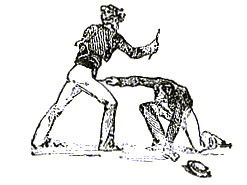
LESSON ELEVEN
Recursos
When the rules already given are insufficient for the diestro to defend against his adversary, or to attack him, he has a need to appeal to the recursos; so called because they often give a solution to that which destreza could not.
The art of wielding the navaja has established some of which we will explain very briefly, as their greater part belongs to that which is known by the name of tretas in the second part of this Instruction.
It is good to know that there are recursos or suplementary rules that reach beyond where the others stop; here is where each diestro puts in practice those which he is better adapted to, or those which he himself has invented.
We will give some examples of recursos.
Belonging to the same class as recursos are the engaños or finjimientos, of which we will now speak.
The concealing of his two hands behind the diestro's back, so that the adversary doesn't see in which of them is the navaja, is a very successful recurso, especialy if before drawing out the armed hand he feints with the other. In order to accomplish this it is enough to lean the body a little toward the side of engaño and move the elbow of the arm which is feinting in the same direction; since the opponent believes the attack is coming from that side, and it is very natural to try to avoid it, by throwing the body to the other side in which he will inevitably recieve the golpe.

Dropping himself to the ground with the naturalness appropriate to someone who has slipped, in a manner that the opponent doesn't suspect that it is an engaño, is a recurso, that well executed can assure the end which the diestro desires; because believing that he has fallen involuntarily, can of good faith strike out at him, who then rises with great speed upon one of the knees and recieves him with the point of his navaja wounding in the lower belly, as represented by the preceding figures. It is a way which requires much agility in the diestro; in such a way, that we have seen it done that the diestro lets the navaja drop from his grip at the same time he falls to the ground, to better decieve his adversary, and in the act of getting himself up recovers it from the ground.
The caida is customarily made from the back; and the method of rising is to brace one foot and the unarmed hand firmly on the ground, and with the rest of the body, give a violent push, situating yourself in the position described.